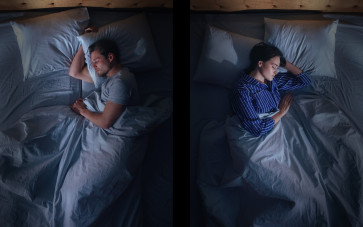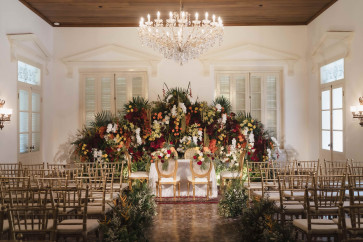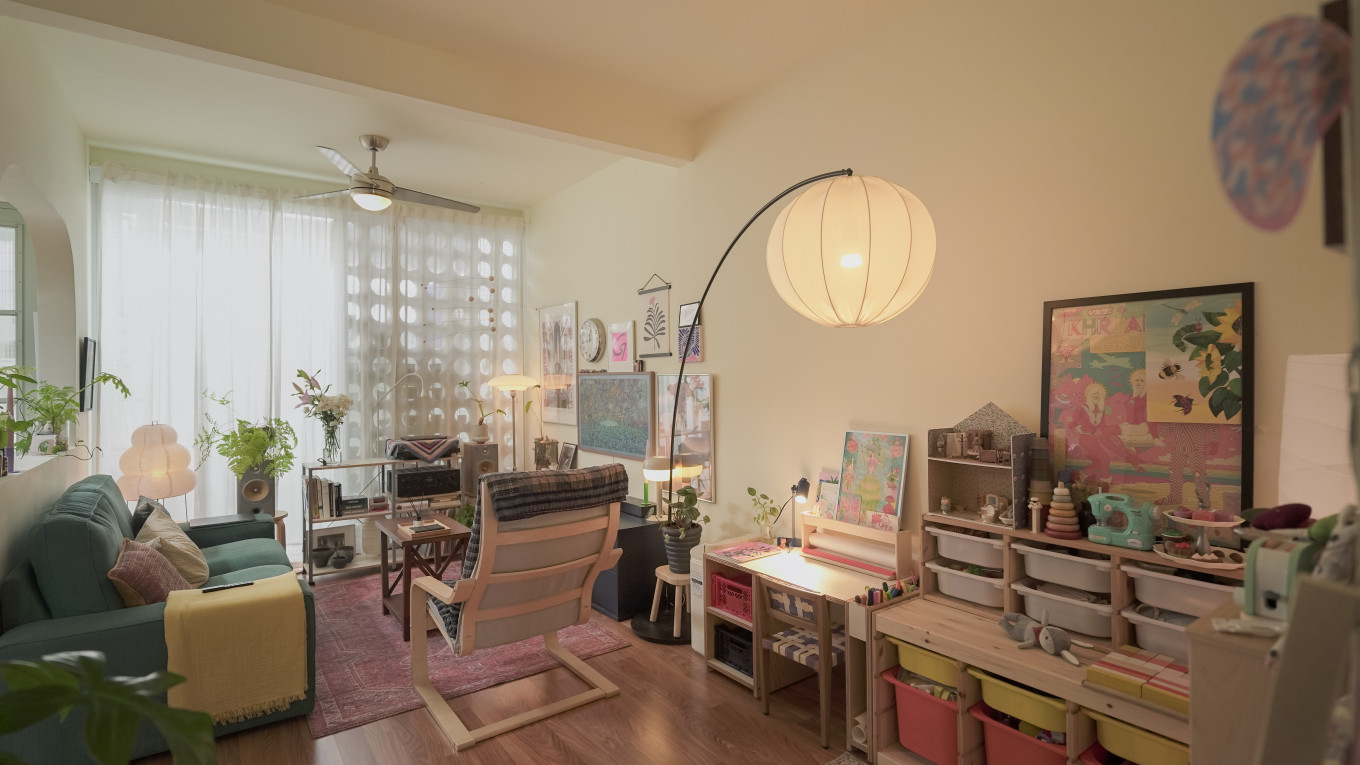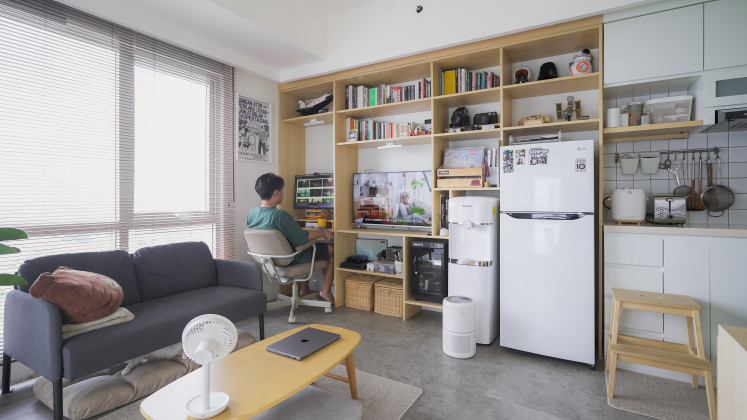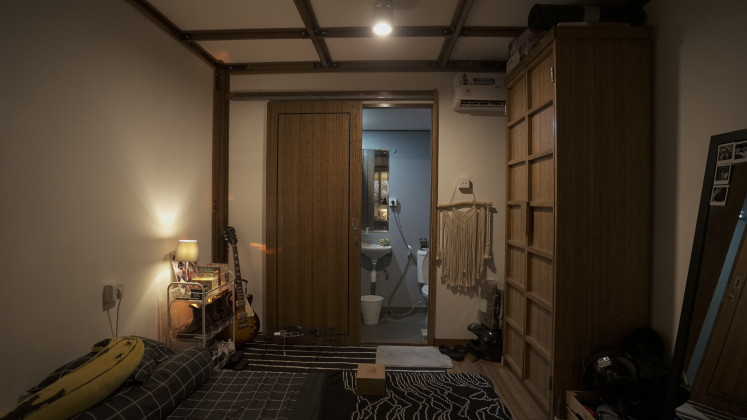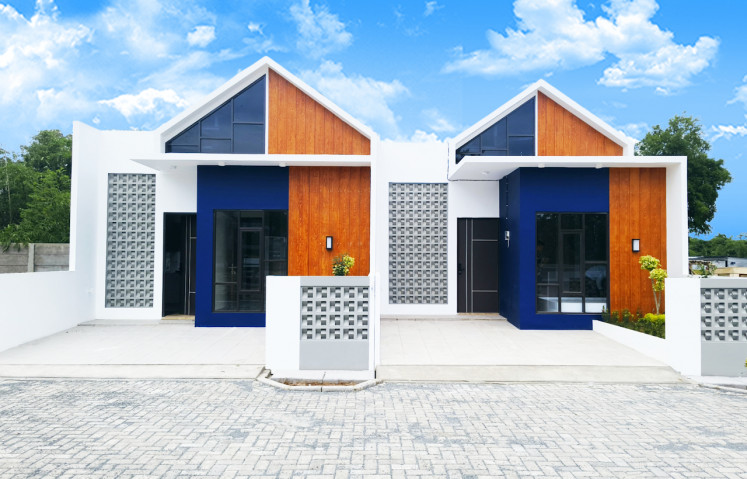(Courtesy of Living Loving)
Though most of today’s young workers have little choice but to live in rental units such as kost-kostan (rooming houses) or small studio apartments to reduce travel time and its associated stress, having a well-decorated living space is an increasingly accessible aspiration because of online inspiration and resources.
During the COVID-19 pandemic, thousands of people stuck at home channeled their creativity through home improvements, and connected with fellow interior design enthusiasts online by sharing their tips and hacks on social media.
Then, as most services shifted online, so too did furniture stores and other suppliers. This made it easier and more convenient for people to browse a range of options, from affordable rugs and trending mushroom lamps to wood vinyl stickers for DIY walls and even indoor plants.
“I think this helped people explore their taste,” says Nike Prima-Dewi, one of the cofounders of Living Loving, a home living platform founded in 2013.
“Although sometimes, it can be zonk,” she adds with a laugh, using the current local slang for disappointment.
Aesthetics

Thank you!
For signing up to our newsletter.
Please check your email for your newsletter subscription.
When it comes to making their living spaces more comfortable, many tend to look beyond utility and find ways to turn their small spaces into aesthetically pleasing homes.
“They typically prepare mood boards and a wide range of references before filling their homes,” says Nike.
Platforms like Living Loving and Architectural Digest make it easier to find ideas. Social media plays a big role too, with apps like Pinterest allowing users to sort their inspiration and preferences into neatly compiled folders as if collecting clippings from magazines. Mood boards, which are basically collections of colors and images of furniture, decor, materials and textures, can then be put together on a graphic-design platform like Canva.
Whether you’re going for the clean lines and warm tones of Scandinavian or Japandi themes, or prefer the bolder glam style or shabby chic, chances are you will find furniture and decor to suit your taste and budget after a few dedicated hours of scouring e-commerce sites or second-hand online marketplaces.
“It was a lot more complicated to buy furniture before,” Nike shares. “Going to hardware stores or furniture specialists was a whole process. People buy online now, you can find just about anything!”
Read also: Generation Rebuild: Fixing the future, one start-up at a timeMulti-functionality
But with smaller spaces the norm in the current economy, people have been forced to become more creative in maximizing their space.
Convertible furniture like sofa beds to accommodate a friend staying overnight, coffee tables that fold out to serve as work desks or foldable dining tables — there are plenty of multifunctional pieces available in the market that save both space and money.
Storage methods have gotten more unique as well. Haven’t got enough space on the floor? The interior designers’ tip is to think vertically. That means installing floating shelves and other forms of wall storage. Hidden storage in ottomans and underneath bed frames are also commonly seen now in small homes.
Overhead lighting can often be harsh, and if it’s a rental unit it is usually white. By incorporating atmospheric lighting, you can give a more spacious feel to your home.
“A lot of people switch out the light bulbs or add warm-toned lamps to their home to give a softer atmosphere,” Nike says, explaining that the wrong lighting combination can bounce off your walls and floors awkwardly, making it look less spacious.
(Courtesy of Living Loving)
Cultural considerations
Nike points out that building a home is a mix of function and value. For example, dining at home is not just about having a seat and a flat surface to eat. A high stool and bar table might look good, but it only serves one function.
“As Indonesians, we have this habit of chatting while eating,” she says. We sit down and have a conversation, because that’s part of our culture. Dining is an intimate act. “[So] later, one might realize it’s better to have a proper dining table and comfortable seats.”
On the other hand, small spaces may require people to sacrifice cultural norms.
“We often highlight more compact homes [on our site]. When one of them doesn’t have a guest area, the comments [from readers] point it out and ask ‘where will the guests be?’” Nike says.
Read also: Old sound, new nation
Personality
It is often said that someone’s living space can truly showcase their personality. Pay attention to the interests or hobbies on display, the cleanliness and layout, and you might just understand them better. After all, it is their personal space.
Nike says that personal spaces also often reflect the lifestyle you wish to achieve. “One time we featured a home without a garage. The owner said they lived with clutter previously, and would like to minimize that aspect.”
Personality is not a stagnant state, much like your home. So if there’s a change you wish to make, you have the freedom to do so. But take the time to assess your space.
“There’s no hurry,” Nike says. “You can always gradually collect things that you like. That way, you can figure out what works best for your home.”
Nike notes that focusing on personal values can significantly impact someone's decisions in homebuilding. Trends in interior design and architecture come and go, much like fashion, albeit with a longer lifespan. “Evaluate your values. A home isn’t just about its appearance; it’s a place where you grow.”
(Courtesy of Living Loving)
Top tips:
- Create a mood board to define the aesthetic style you want to achieve
- Look for furniture pieces that have multiple functions
- Take advantage of vertical and hidden storage for small spaces
- Incorporate atmospheric lighting to create a softer ambience
- Make choices that reflect your culture and personality
Read also: Changing beauty trends: Healthy, natural and localThis article is part of The Weekender, a biweekly tabloid that appears in the Saturday edition of The Jakarta Post. Offering a variety of feature articles on lifestyle and culture, it aims to enriching your reading experience. Subscribe here to access The Jakarta Post's Saturday edition and all Premium content.













